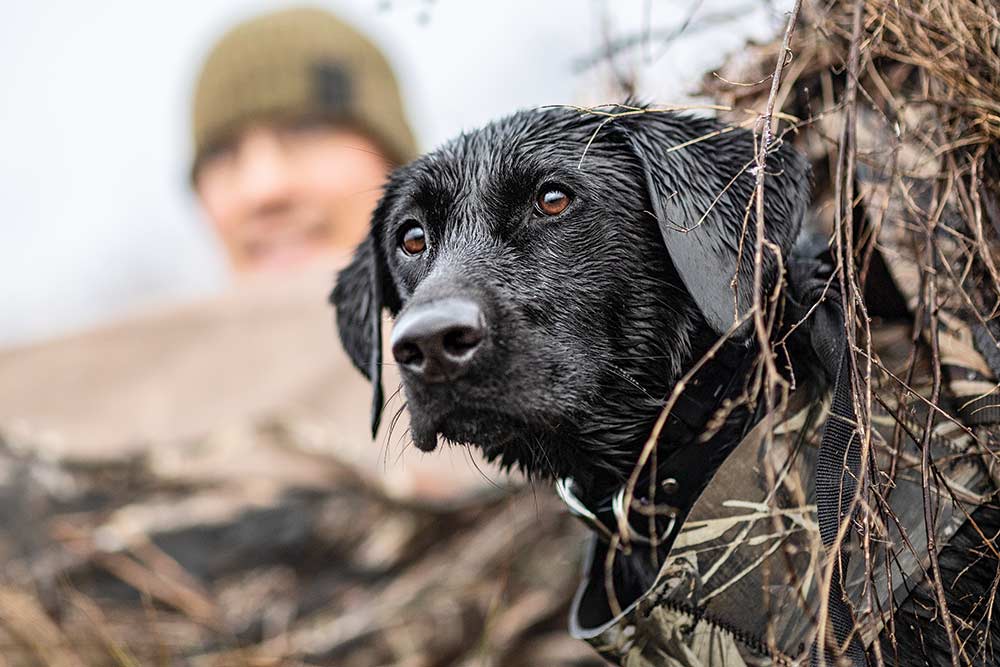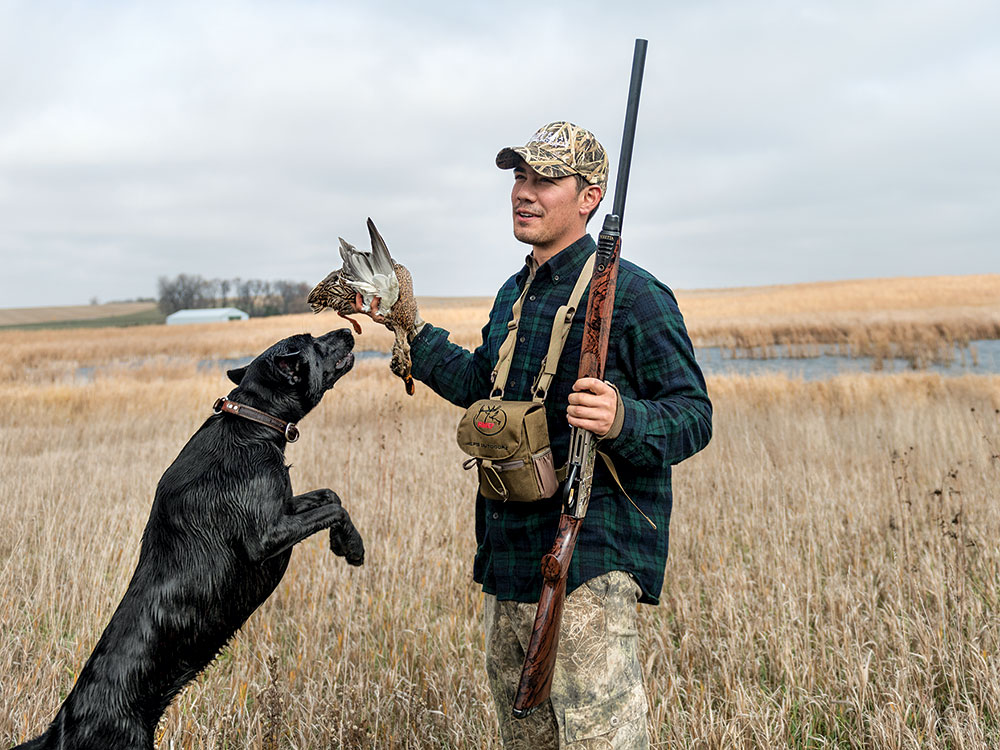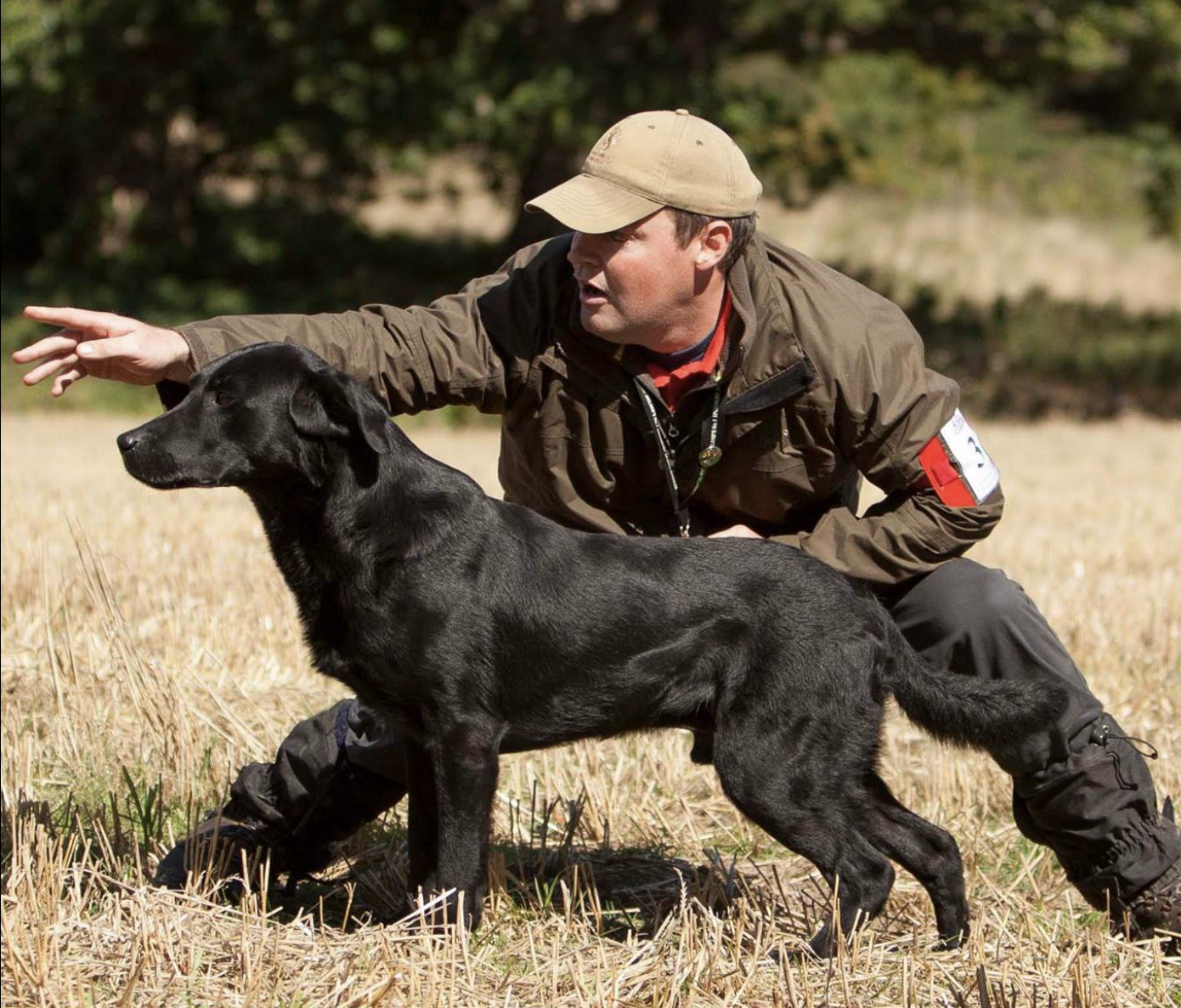If you’re looking for a verdict on the English vs American Lab debate, I’ll tell you right now: American Labradors are the clear winner. They’ve got good looks, athleticism, and hunting drive in spades. But that matchup is like pitting a dressage pony against a cowboy’s quarter horse: It doesn’t make a whole lot of sense because they have two very different jobs.
A more apt comparison is between British and American Labs. Because we Americans are notoriously bad at geography, we often use “English” and “British” interchangeably. When it comes to working retrievers, this matters because English Labs are not the same thing as British Labs. English Labs are the stocky, blocky, square-headed Labs that look more suited for napping than fetching. They are traditionally show dogs, or conformation dogs, from England.
British Labs, or field Labs, are bred for hunting and field trial work, and they look an awful lot like healthy American Labs: athletic, lean, and lively. “British” simply means these Labs have bloodlines originating in the British Isles, which includes England, yes, but also Ireland, Scotland, and Wales. (My own British Lab happens to be Irish.) Still, there are plenty of differences to note between British and English vs American Labs. Here’s a rundown.

The English Lab vs American Breed Standard
The American Kennel Club recognizes a single breed of Labrador retriever. In other words, English, British, and American Labs aren’t distinguished by any major genetic differences—they’re all just Labrador retrievers. That’s why the AKC’s and the UK Kennel Club’s descriptions of what an ideal Lab looks and behaves like have far more similarities than differences. For example, Labs from both America and England should have friendly eyes expressing “intelligence and good temper” and a tail that “may be carried gaily but should not curve over [the] back.”
While physical differences can and do exist between American and British retrievers (more on this in a minute), size is usually the only reliable indicator of heritage, says Dave Bavero, owner of Waterstone Labradors in Boerne, Texas. British Labs tend to be smaller than American Labs.
Instead of major genetic differences, behavior and training preferences have shaped Labs so they reflect, somewhat comically, the stereotypes of their owners. American Labradors are vocal, enthusiastic, high-strung. English and British Labs are reserved, quieter, polite.
Physical Characteristics of Labs
Because the following characteristics are generally but not always true, a dog might be larger or smaller than the measurements associated with their bloodlines. Or they may have a mix of traits, like a blocky head and curving tail. When it comes to the English vs American Lab, overall size and personality is often a better indicator of breeding.
One note: The classic “otter tail” that is desirable in all Labs refers not to the length or curvature of a Lab’s tail, but to its rounded shape padded out with thick, dense hair. (If you’ve ever grabbed your Lab’s wagging tail to keep it from whacking you, you’ll understand.)
| American Lab | British Lab | English Lab | |
| Weight | AKC breed standard for males: 65 to 80 pounds; females: 55 to 70 pounds |
No KC breed standard given. On average, males: 50 to 70 pounds; females 45 to 60 pounds | No KC breed standard given. On average, males: 50 to 80 pounds; females 45 to 60 pounds |
| Height | AKC breed standard for males: 22.5 to 24.5 inches; females: 21.5 to 23.5 inches |
KC breed standard for males: 22 to 22.5 inches; females: 21.5-22 inches | KC breed standard for males: 22 to 22.5 inches; females: 21.5-22 inches |
| Body | Athletic, lankier body, slimmer chest | Athletic, compact body | Thick body, stocky, barrel-chested with larger neck |
| Head | Narrower, more slender | Narrower, can be square | Blocky and often thick |
| Legs | Longer | Shorter | Shorter |
| Tail | Curvier, otter tail | Varies, otter tail | Straighter, otter tail |
| Coat | Thinner coat | Thicker coat | Thicker coat |
| Vocalizations (barking, whining) | More vocal | Quieter | Quieter |
| Energy and temperament | High-drive, high energy | Great drive, calmer in the home | Fair drive, calmer in the home |
Energy Levels and Temperament

There’s a reason the Labrador retriever reigned supreme as America’s most popular dog breed for three decades. Labs are versatile dogs known for their energy, trainability, affection, and playfulness. They make great family dogs and dedicated, reliable working dogs. Both American and British Labs thrive with proper obedience training and regular exercise. Because they’re descendants of the extinct St. John’s water dog—a breed that helped fishermen in Newfoundland retrieve their catches—most Labs love water.
As with all dogs of a particular breed, individual Labs have individual personalities. Still, American Labs have a reputation for high energy. They are often vocal (known to bark and whine to express themselves) and can be rambunctious at home. The old saying that Lab puppies finally calm down when they turn three is especially apt when describing American Labs. This is because American Labs are a sporting breed, and breeders have historically prioritized high drive in their litters and continue to breed for those traits.
While the Brits also breed Labradors with retrieving drive in mind, they tend to prioritize calmness and quietness in their dogs. That’s why British Labs have a reputation as well-mannered house dogs.
“I have 15 dogs,” says Matty Lambden, a field trial judge and owner of Tamrose Labradors in central Ireland. “I could walk around me kennels and there won’t be one—not even one squeak. It’s a fault [in the UK]. If your dog whimpers in line, he’s gone. You drove three hours and the dog gives a bit of a cry, he’s out the door and you’re knocked out of the competition. So that’s why we don’t proceed with that [trait] or breed off those dogs. You’re better off putting all [your efforts] into a dog that you know is going to be quiet.”
Trainability of the English Lab vs American

While both American and British Labs are highly trainable and eager to please, the general rule is that American Labs are more resilient to pressure. Pressure refers to physical corrections, ranging from the tug of a leash to e-collar stimulation and force fetching. The reason pressure matters is that a training misstep with a softer dog is likely to have outsize consequences.
“Get a dog that has enough talent that they’re going to make up for your mistakes,” retriever trainer Tom Dokken advises owners interested in training their own Lab. “Because if you get a dog that’s super soft and you’re making mistakes at the wrong time, you might just shut that dog totally down. Whereas a professional trainer, if he has enough experience, he’s evaluating that dog early on to know where that dog’s limits are and where the correction levels are in order to keep it working.”
British Labs are known for their soft temperament and can shut down under too much pressure. It’s not an insult to tell a Brit their dog is soft. On the contrary, it’s a desirable trait and one of the reasons force fetching and e-collar training is almost nonexistent in the UK and among devotees of British-style dog trainers. In fact, British handlers often don’t put any collar on their dog at all. When I asked one British trainer why he didn’t keep collars on his dogs, he shrugged and said he thought they looked better without it (he wasn’t wrong). It’s also something of an obedience humble brag. My dog, he seemed to be saying, doesn’t need a collar.
Which Lab Is a Better Hunting Dog?
You could start bar fights over which breeds and even bloodlines make the best hunting dog breeds. If you ask American Lab handlers which Lab is the better hunting dog, they’ll assure you it’s an American. Brits will tell you just the opposite. (Few people will try to convince you English Labs make good hunting dogs.) In reality, the best Lab for you depends on the kind of hunting you’re planning to do, and what you prioritize in a dog.

“I always tell people to get the best bloodlines you can buy,” says Dokken, the legend behind Dokken’s Oak Ridge Kennels and the inventor of the Dead Fowl Trainer. . “I don’t care if it’s British, American, whatever it is. You can have dogs—again, whether it’s British or American—that have some talent. And then you can have dogs that have a lot of talent.”
Dokken has worked with thousands of dogs over his four-decade career and trained both American and British Labs. He doesn’t play favorites and if you ask him which he prefers, his answer is always the same: “One that wants to work.”
Still, in his decades of hunting and training, Dokken has personally owned five Labs; all five have been American. My British Lab and I trained at Dokken’s farm in South Dakota, a wind-swept prairie with big water and thick cover. It’s a fair microcosm of American bird hunting. Retrievers in the U.S. are often asked to navigate ocean surf for sea ducks, swift rivers for mallards, and half-frozen potholes for pintails. Our hunters work dogs in prickly desert, steep mountains, and dense woods for quail, chukar, and grouse. Hunting here is more dangerous than in tidy British farm ponds and neat hedgerows.
For that reason, it’s smart to get a high-intensity dog whose drive overwhelms the potential for discomfort or disinterest when the hunting gets tough or slow. On average, that’s probably going to be a Lab with American bloodlines.

If quiet mornings and perfect blind manners are important to you, consider a British Lab. Duck hunting in particular includes lots of slow mornings, and a trained British dog will usually be able to wait out the doldrums silently and without fidgeting. (The same is true of an English Lab vs American if you’re determined to hunt with one.)
Here’s an example: One of the best duck dogs I’ve ever hunted over was an American Lab. That dog was steady, obedient, and had drive oozing out his ears. In the blind, he whined like a spoiled kid doing chores on a Saturday. Ultimately my buddy would get annoyed with his dog and I’d get a headache. (Whining in dogs, Dokken says, is usually involuntary—they don’t know they’re doing it, so it’s often impossible to correct.) Meanwhile, my own pup began his duck hunting career with more uncertainty than a hard-charging American Lab, but he stays naturally quiet, stays put when I ask him to, and picks up ducks just fine.
Labrador Retrievers in Field Trials

British Labs have always made good hunting dogs, says Bavero, but they’ve historically been dismissed by American handlers for field trials and hunt tests.
“The stigma has been that British Labs are not as competitive of dogs, but you’re starting to see more of them in trials,” says Bavero, who began importing Labs from Ireland with his business partner in 2018. “But a lot of that stigma has been how we [Americans] have been training them: If you want to run a hunt test, you have to put a lot of pressure on the dogs. … The American style has been kind of what we do with most things. Build them up and break them down.”
Bavero finds that U.S. competitions tend to emphasize blind retrieves and focus on a handler’s ability to direct their dog right to a bird rather than letting the dog hunt naturally. Dogs require exceptional drive to endure the tedium of advanced handling drills, so Americans breed for that energy.
READ NEXT: Best GPS Collars
Meanwhile, Brits breed for what Bavero calls “natural game-finding ability,” a trait that’s rewarded more in British hunt trials, where dogs are handled to an area, then encouraged to search for birds as they would while hunting. Handling is still required but it’s less technical. The cultural emphasis on honoring other dogs has also resulted in calm, steady lines.
FAQs
Which Lab is smartest?
Neither English nor American Labs are known for their smarts, unfortunately. Among an intelligence study of 13 dog breeds, Labs came in last. But in some ways that’s an advantage: Labs generally do what you tell them because they’re biddable, eager-to-please dogs. Much like people, a Lab’s intelligence varies based on his environment, genetics, and (to a certain degree) his training—not his country of origin.
Are English or American Labs easier to train?
This depends on what you want out of your dog. If you want to train a polite, biddable, quiet dog that can stay glued to one spot and earn plenty of praise from strangers, consider a British or English Lab, both of which are bred with an eye for manners. If your priority is to train a hard-charging, high-energy working or hunting dog that just won’t quit, get an American Lab. Remember that these are just general rules with plenty of overlap: American Labs take well to obedience training and British Labs make fantastic working dogs.
Is an American Lab a good family dog?
Absolutely. American Labs are affectionate, friendly, and excellent with children. They make great companions and service dogs, and they are also more likely to protect your family and your home than, say, a golden retriever vs Labrador. The same is true for British and English Labs.
Which colour Labrador is best?
Which colour Labrador is best?
This is a personal preference. The most widely accepted color among Labrador purists is black, although black, chocolate, and yellow (which includes fox red) are all accepted by the American Kennel Club. Each coat color has its advantages. Non-standard colors like cream, silver, and other “designer” colors can be controversial among traditionalists but also have their fans. You can learn more about Labrador retriever colors here.
Can a Lab be both English and American?
Yes. A Lab’s heritage is determined primarily by bloodlines, which means a Lab can be both English and American. For example: a puppy can be both if her dam is from U.S. bloodlines and her sire has English bloodlines. Still, most breeders are purists who don’t usually mix international pedigrees. Also, remember that a dog’s breeding determines its heritage—not its country of origin. A puppy born in Michigan, for instance, can still be a British Lab if her sire and dam have British bloodlines.
Final Thoughts
British and American Labs are more similar than they are different. If you’re determined to compare the two, British and English Labs are generally shorter, quieter, and calmer. American Labs are known for their athleticism, high drive, and enthusiasm. But instead of worrying about whether a British or English vs American Lab is “better,” pay attention to which dog is right for your needs and lifestyle. Do your homework and choose a responsible breeder. If you get a chance to see a breeder interact with his dogs and, better yet, meet the sire and dam of a litter you’re considering, do it. Once you’ve made your decision, you’ll fall in love with whichever Lab you take home—no matter what his pedigree says.
